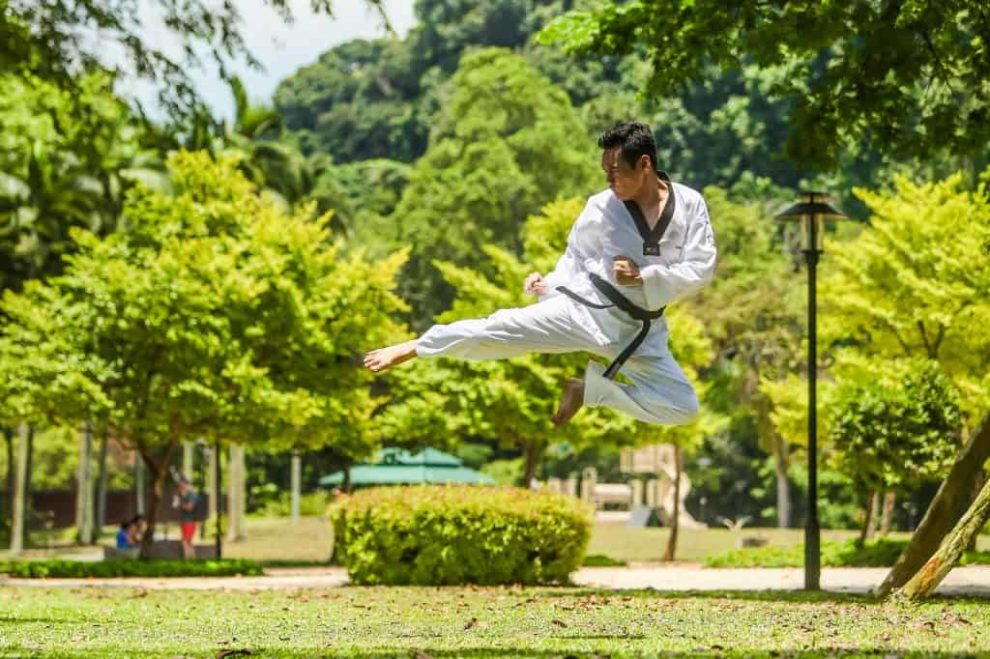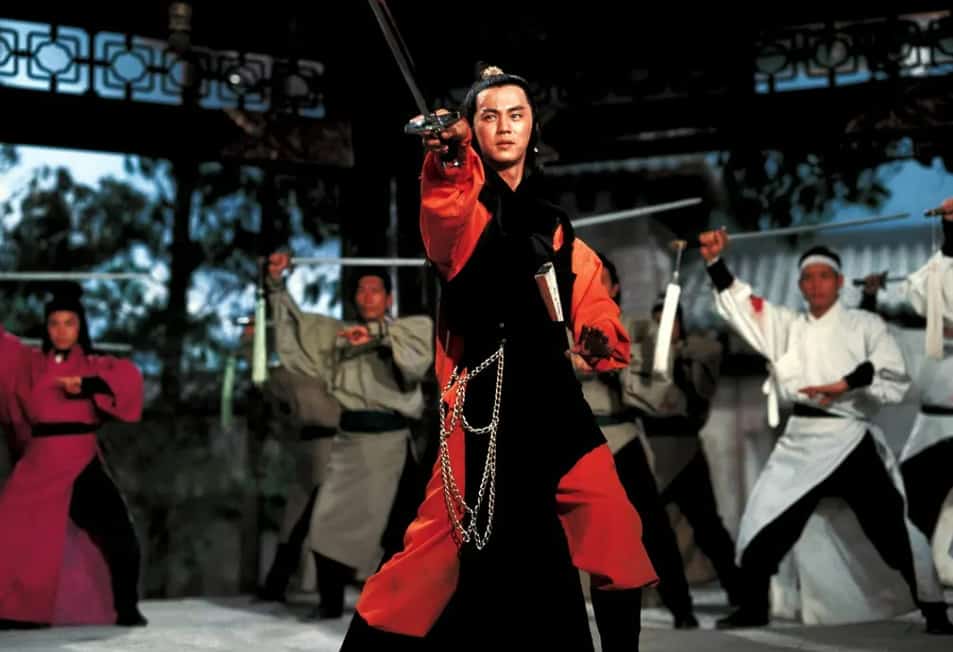the article was originally published at The MMA Guru
Kung fu is an ancient form of martial arts that has been passed down from master to student. Traditionally, kung fu did not have a belt system. Instead, students would signify moving through the ranks with a scroll signed by the master they were training under.
Eventually, belts were used in kung fu to signify seniority within the practice. Masters would pass on different colored belts to their students as a demonstration of moving through their journey toward mastery. Today, moving through the kung fu belt system is proof of achievement and encouragement for students looking to progress.
What Is Kung Fu?
Unlike karate and other forms of martial arts that have origins in Japan, kung fu has origins in China. Monks practiced kung fu early on for health and self-defense on their quest toward enlightenment.
While some may think of kung fu as a singular discipline, it is a broader umbrella that encompasses other forms of martial arts, tai chi, Hung Ga, Wing Chun, and Xingyiquan being the most well-known.
Kung fu is a passive practice in the sense that it focuses on self-defense. Much of your intermediate and advanced training will focus on someone attacking you, and how you combat that.
The Animal Styles of Kung Fu
Along with the symbolism of the different belt colors, kung fu has several animals that help interpret different meanings of movements and forms.
Snake
The snake is used to teach the smooth movements and slow stances of kung fu. Like the snake waiting to attack, they can also symbolize speed and counterattacks. Snake stances are upright and mobile while allowing for quick advances and sidestepping.
Unlike the other kung fu animal techniques, the snake does not incorporate hard punches. Those practicing the snake style rely on bobbing and weaving to evade attacks and rapid, alternating jabs when striking.
Tiger
The tiger is considered to be one of the most powerful animals in Chinese astrology, and those who practice tiger-style combat in kung fu also rely on its powerful advances. If you practice tiger-style combat, you tend to charge your opponent with direct attacks.
While tiger-style fighting will sometimes use low kicks, this style relies heavily on rapid, circular arm movements intended to overwhelm an opponent. The tiger claw strike is the most popular movement in tiger-style combat. To perform this technique, you strike your opponent with the heel of your palm, but keep your fingers bent into a claw shape. Many times, fighters try to hit an opponent in the jaw area with a tiger claw strike.
Leopard
The leopard is known for its speed, so leopard-style kung fu attacks are focused on the elements of surprise and speed. Leopard-style techniques utilize low kicks and elbow and knee strikes.
The leopard fist is the most popular leopard-style form that allows you to attack an opponent using the front or back of your fist to punch or strike. Leopard fists are versatile and can be delivered from different angles.
Crane
The crane is a long, graceful bird known for its elegance. In kung fu, the crane stance is one of the most widely known stances commonly used in kung fu and Tai Chi forms. To perform the crane stance, you stand on one leg with the other bent up by your knee and arms outstretched.https://www.youtube.com/embed/MEFTdGTQ-bU?feature=oembed
Dragon
Despite being a mythical creature, dragon-style kung fu is famous and widely taught. Dragon-style kung fu draws inspiration from spirituality and mythology with gentle, fluid movements.
Before you can practice the hits and kicks of dragon-style kung fu, you must first draw energy from yourself and your surroundings. Northern dragon-style techniques draw energy from the ground, and the southern dragon-style focuses more on fluidity. As opponents, the northern style will stand its ground while southern style focuses more on evasion and overwhelming an opponent.
Kung Fu Belts
Kung fu has origins from Chinese theater. Here, performers would wear colorful sashes as part of their performance. The colors of the belts held no meaning until a kung fu belt system was established.
Unlike other forms of martial arts that use thick, cotton, or wool belts to signify moving through the ranks, kung fu uses a more traditional sash-style belt that is typically made of silk. Some modern kung fu belts are made of a thinner cotton material stitched to make a wide sash-like belt. In kung fu, fighters sometimes use their belts as weapons against opponents, and the wider silk material is stronger than cotton or wool.
Earning Your First Belt
Depending on the school, you may not enter the kung fu belt system until you have earned your first belt. Some schools may give you a white belt to begin your training, while others may make sure you understand some basic concepts to earn your white belt and continue training.
As you progress through white belt training, you will build on the foundations of how to stand, kick, and punch, and how to escape basic holds. Building on these basic techniques, you will begin to develop your chi, learn breathing techniques, and complete basic kicks and stances to move to yellow and more advanced belts.
To complete your belt test, you must demonstrate that you understand and can execute the required basics in your new skill level.
Novice
Along with white, novice athletes training in kung fu will earn a yellow belt followed by a green one, after you pass the required tests. Depending on the school you attend, you may also be required to earn an orange belt before you can earn a green one.
As you progress from yellow to green, you will learn more technical skills, including kicks and forms. Working through your yellow belt will help you develop the skills that you will apply throughout your belt system training. Some black belts admit that their yellow belt was the most challenging of their kung fu training because it is essential to understand the fundamentals to draw from them and expand on them at all levels of practice and mastery.
Intermediate
Once you understand the fundamentals of kung fu, you will earn your blue belt, followed by a purple belt. These belts signify your intermediate stage of the belt system and your kung fu training.
Intermediate level training begins to incorporate weapons by building on techniques you have already learned. You also learn more complex forms and stances that focus on self-defense. As an intermediate student, you will learn how to defend yourself against multiple attackers, and more complex martial arts moves like leg locks, takedowns, and full body sweeps.
Advanced
Becoming an advanced kung fu fighter involves a lot of practice and understanding of the principles of kung fu. Advanced students start to work their way up through the brown belt ranks. Some schools have first, second, and third-degree brown belts, while others move from brown to red.
Advanced training incorporates advanced weapons and focuses on sparring with an opponent. Advanced belts may also begin to teach new students when training to earn their black belt. Being an advanced belt kung fu fighter is an impressive accomplishment, but you still have some training to become a black belt fighter.
Black Belt
Like other forms of martial arts, black belt kung fu fighters are considered masters of the art. This is the only colored belt that is regarded as qualified to teach kung fu. Once you have earned a black belt, you can earn up to nine degrees of additional training within the black belt ranking, but the level of advanced training varies.
Additional training comes with attaining black belt status. A black belt student learns philosophical concepts associated with kung fu and unique katas, which are choreographed forms and patterns used in martial arts.
Becoming a Master
Kung fu masters generally receive this ranking after completing an additional eight years of training after receiving your black belt. Masters must also have a minimum of 11 years of training overall.
Achieving Kung Fu Grandmaster Status
To achieve the title of kung fu grandmaster, you must be appointed by a retiring grandmaster. Grandmasters earn this status by training many kung fu masters as well as meeting some traditional requirements:
- Holding the rank of a current kung fu master
- Having instructed kung fu for 30 or more years
- Having taught a son or daughter to a black belt ranking
- Having taught a grandchild to a black belt ranking
- Remaining true to the philosophies and teachings of your predecessors and other well-known, respected kung fu grandmasters
Mastering the Kung Fu Belt System
It takes a lot of work and dedication to work through the kung fu belt system. Like other forms of martial arts, kung fu is heavily based on traditions and philosophies that have been passed down through generations. To become a black belt and kung fu master, you must understand the history and forms associated with the art as you make the more aggressive moves.
The kung fu belt system is different from that of other martial arts like Jiu Jitsu or Muay Thai. Earning a kung fu belt shows a commitment to century's old training and can also be a great way to stay in shape or protect yourself. The skills you need to attain your belts will teach you self-discipline, improved form and posture, and fundamentals of proper self-defense.















